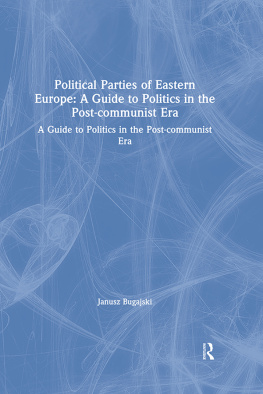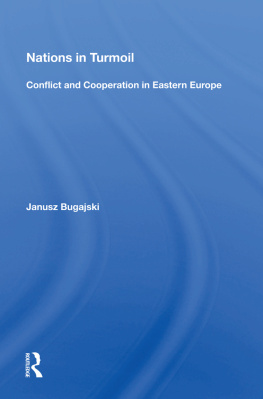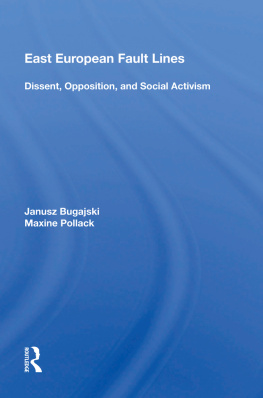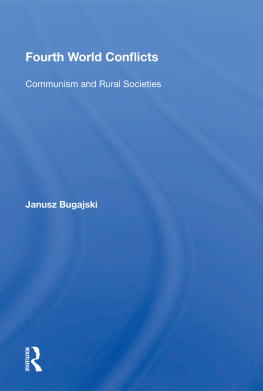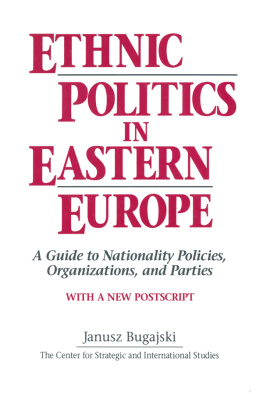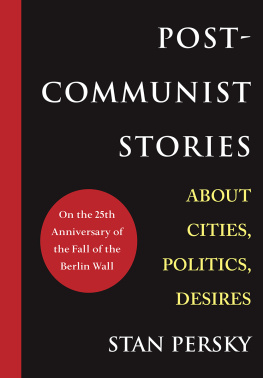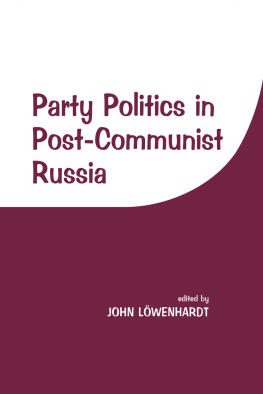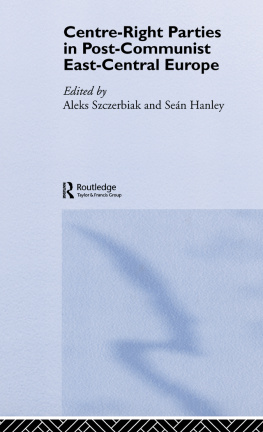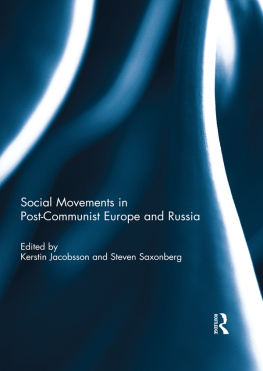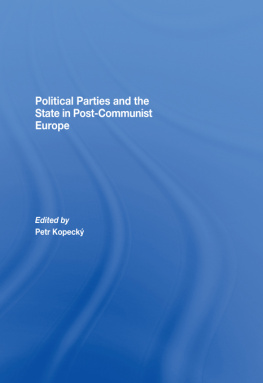First published 2002 by M.E. Sharpe
Published 2019 by Routledge
2 Park Square, Milton Park, Abingdon, Oxon OX14 4RN
52 Vanderbilt Avenue, New York, NY 10017
Routledge is an imprint of the Taylor & Francis Group, an informa business
Copyright 2002 Taylor & Francis
All rights reserved. No part of this book may be reprinted or reproduced or utilised in any form or by any electronic, mechanical, or other means, now known or hereafter invented, including photocopying and recording, or in any information storage or retrieval system, without permission in writing from the publishers.
Notice:
Product or corporate names may be trademarks or registered trademarks, and are used only for identification and explanation without intent to infringe.
Library of Congress Cataloging-in-Publication Data
Bugajski, Janusz, 1954-
Political parties of Eastern Europe: a guide to politics in the post-Communist era / by Janusz Bugajski.
p.cm.
Includes bibliographical references and indexes.
ISBN 1-56324-676-7 (alk. paper)
1. Political partiesEurope, EasternDirectories. 2. Political partiesFormer Soviet republicsDirectories. 3. Post-communismEurope, Eastern. 4. Post-communismFormer Soviet republics. I. Title.
JN96.A979 B84 2002
320.94709049dc21
2001032823
ISBN 13: 978-1-56324-676-0 (hbk)
I dedicate this book to Margarita,
who finally saw me emerge from a stack of paper and
a pile of airline tickets and still recognized me.
For the life and love we share.
Contents
I. Baltic Region
II. Danube Region
III. Adriatic Region
IV. Black Sea Region
This guide provides detailed coverage of political developments in eighteen countries of Eastern Europe as well as two distinct political entities Montenegro and Kosovathat were not internationally recognized states at the beginning of the twenty-first century. Both territories were still technically part of the Federal Republic of YugoslaviaMontenegro as the sole remaining federal partner of Serbia, and Kosova as a province of Serbia. However, developments in the two territories in the late 1990s had effectively severed their political systems from that of Serbia, and so they will be treated separately here.
This encyclopedic volume took much longer to complete than was initially envisaged. The breadth and scope of the undertaking, spanning twenty countries and aspiring states, has involved extensive and intensive research, data gathering, fact sifting, and the condensing of pertinent material. Unlike in communist times, when a little information often went a long way, since the collapse of the single-party regimes, the sheer volume of information available has necessitated long hours of careful reading, analysis, and selection. Moreover, the rapidity and complexity of developments throughout Eastern Europe continue to perplex the layperson and specialist alike and invariably undermine conclusions and predictions. Work on this book also was slowed by my frequent trips to the region and by the various programs on behalf of the region conducted at the East European department at the Center for Strategic and International Studies (CSIS), in Washington, D.C.
The completion of this monumental endeavor would not have been possible without the encouragement and assistance that I have received at CSIS over the years. In particular, I am most indebted to Ilona Teleki, my research associate for her outstanding research skills and determination to bring this volume to fruition. Sudabeh Koochekzadeh also played a pivotal role in the various book-related projects. Among the legion of interns and research assistants who painstakingly gathered and processed the raw material, I must mention: Vesna Grujicic, Dominika Dabrowska, Lada Trifonova, Paul Nemes, Zlatica Sandels, Lana Skrtic, Ioana Copil-Popovici, Darko Pavlovic, Zuzana Jasenovkova, Marketa Houskova, Admrela Balic, Marusa Jamnik, Andrew Astapov, Karolina Ristova, Sonja Andonova, Thomas Hessel, Neven Crvenkovic, and Nevena Assenova. I would also like to thank all my interlocutors in the region, who are too many to mention, as well as the helpful staffs at several embassies in Washington, D.C., especially the Albanian, Macedonian, Czech, Ukrainian, Belarusian, Estonian, Lithuanian, Montenegrin, Slovak, Bulgarian, and Latvian missions.
More than a decade has passed since the one-party communist regimes in Eastern Europe collapsed like a row of dominos. The demonstration effect and the prospects of democratic diffusion helped scholars account for the rapid unraveling of communism. However, the demonstration that communist rule was brittle throughout the region did not automatically ensure the expected effect of crystallization of liberal democracies. Some of the new political leaders sought to preserve certain autocratic elements and even to weaken many initial democratic gains. Early predictions of rapid democratization and economic liberalism proved too optimistic, and warnings about the imminent rise of ultranationalism and perpetual ethnic conflicts proved too pessimistic. Instead, the eastern half of Europe has witnessed enormous diversification in the pace and content of political and economic transformation, and numerous challenges to the completion or consolidation of the democratization process. Indeed, the region as a whole can be viewed as an ongoing experiment in pluralism and liberalism, the results of which continue to vary from state to state.
In the wake of the 1989 revolutions many observers assumed that democracy, civil society, and market economics were so closely interrelated that the demise of single-party rule would herald the birth of all three pillars of a liberal order.1 They disregarded a number of essential variables, including the legacies of communism, the social and cultural contexts in which the new institutions were supposed to function, the effectiveness of these institutions, and the new threats and challenges to democratic reform. The transformation process in the eastern half of Europe has involved fundamental shifts in public expectations, aspirations, responsibilities, and relationships with the state and with the emerging market system.
This introductory chapter provides an overall assessment of political development in the region, viewing the emergence of political parties and systerns in a broader social and national context. It considers in turn the complex transition process, the persistent legacies of communism, the relationships between democracy and pluralism, the importance of constitutionalism and the separation of powers, authoritarian challenges to liberalism, nationalist threats to democracy, and the gradual emergence of a broad political spectrum. This overview enables a more informed assessment of the developing political structures in each of these twenty existing and aspiring East European states.
Eastern Europes Transitions
The political earthquake that shook Eastern Europe in the fall of 1989 was a revolutionary event. It marked both the end of the one-party communist states imposed and maintained by an outside power (the Soviet Union), and the beginning of a comprehensive transformation of the regions political, economic, and social structures. This was the third time in a century that Eastern Europe had been convulsed by rapid systemic change. But unlike the national liberations of 1918 and the communist takeovers of 19451948, the 1989 revolutions proved remarkably peaceful. They developed without the threat of outside military intervention; they were generated and propelled by widespread public involvement; and they were directed by political actors who sought a smooth transition from monism to pluralism. In many respects (outside of Romania), these were negotiated revolutions whose leaders capitalized on profound social discontent to press for a new political arrangement, while in most instances avoiding mass arrests or purges of the outgoing regimes.

